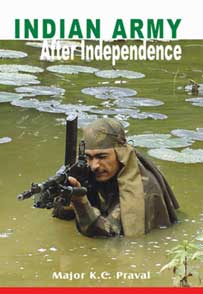There was a pause in the operations after Kotli was abandoned. Till then ad hoc missions had been undertaken as and when the situation demanded.
No serious opposition was encountered up to Jhangar, though progress was slow owing to numerous road-blocks with felled trees, boulders and demolished culverts. At Jhangar, two companies of 3/1 Punjab19 joined the brigade. The road to Kotli now passed through mountainous country, where it was easy for a few men to hold up the whole column. Three kilometres North of Dungi, the brigade was held up for two days while armoured cars and field guns pounded enemy positions. There was also a sharp encounter on the Ban River, at the outskirts of Kotli, where the enemy had partly destroyed the bridge and placed a 3-inch mortar and automatics to cover the rest of it.
Kotli had been under siege for some weeks, and there was great jubilation among its people when Brigadier Paranjpe entered the town on 26 November. But the joy was short-lived for by evening came the news that Mirpur had fallen. With Mirpur in enemy hands, Kotli could no longer be held and the town was abandoned two days after its relief. 15,000 refugees had taken shelter in Kotli before the siege began. Taking them along, the brigade column made its way back to Jhangar, and the rest of the brigade returned to Naoshera. The link-up, a controversial military decision to begin with, failed in its entirety.
| Also read: |
There was a pause in the operations after Kotli was abandoned. Till then ad hoc missions had been undertaken as and when the situation demanded. Now, a stock-taking was ordered with a view to planning for the future. In an appreciation made about this time, Russell stated that the enemy, estimated at about 20,000 men and led by ex-officers, could move in motor transport along roads leading from the tribal territory and West Punjab right into the state’s territory. Russell thought that the enemy would not again try conventional Army tactics and would move along roads and valleys en masse, thus providing a good target to Indian forces. Large-scale attacks against established garrisons were considered unlikely and it was thought that the enemy would take revenge by striking against places in the Punch, Mirpur and Uri areas, where the terrain suited irregular tactics.
 According to him, there were two alternatives for India: station sufficient troops to keep the raiders out or abandon Punch so as to cut down commitments. Induction of more troops would create maintenance difficulties especially in the isolated Kashmir Valley in winter. At the same time, it was realized that abandonment of Punch would give the enemy a base from which it could launch attacks against the Uri sector as well as Jammu. Russell’s recommendation was to restrict the tasks in Jammu & Kashmir to those already laid down by the Government. The Joint Planning staff also endorsed these views. It recommended that the district of Jammu and Kashmir Valley should be strongly held, and from these bases self-contained fighting groups should exploit any opportunities that came along. Military action West and South of Uri and North of Naoshera was to be confined to vigorous patrolling and commando missions.
According to him, there were two alternatives for India: station sufficient troops to keep the raiders out or abandon Punch so as to cut down commitments. Induction of more troops would create maintenance difficulties especially in the isolated Kashmir Valley in winter. At the same time, it was realized that abandonment of Punch would give the enemy a base from which it could launch attacks against the Uri sector as well as Jammu. Russell’s recommendation was to restrict the tasks in Jammu & Kashmir to those already laid down by the Government. The Joint Planning staff also endorsed these views. It recommended that the district of Jammu and Kashmir Valley should be strongly held, and from these bases self-contained fighting groups should exploit any opportunities that came along. Military action West and South of Uri and North of Naoshera was to be confined to vigorous patrolling and commando missions.




